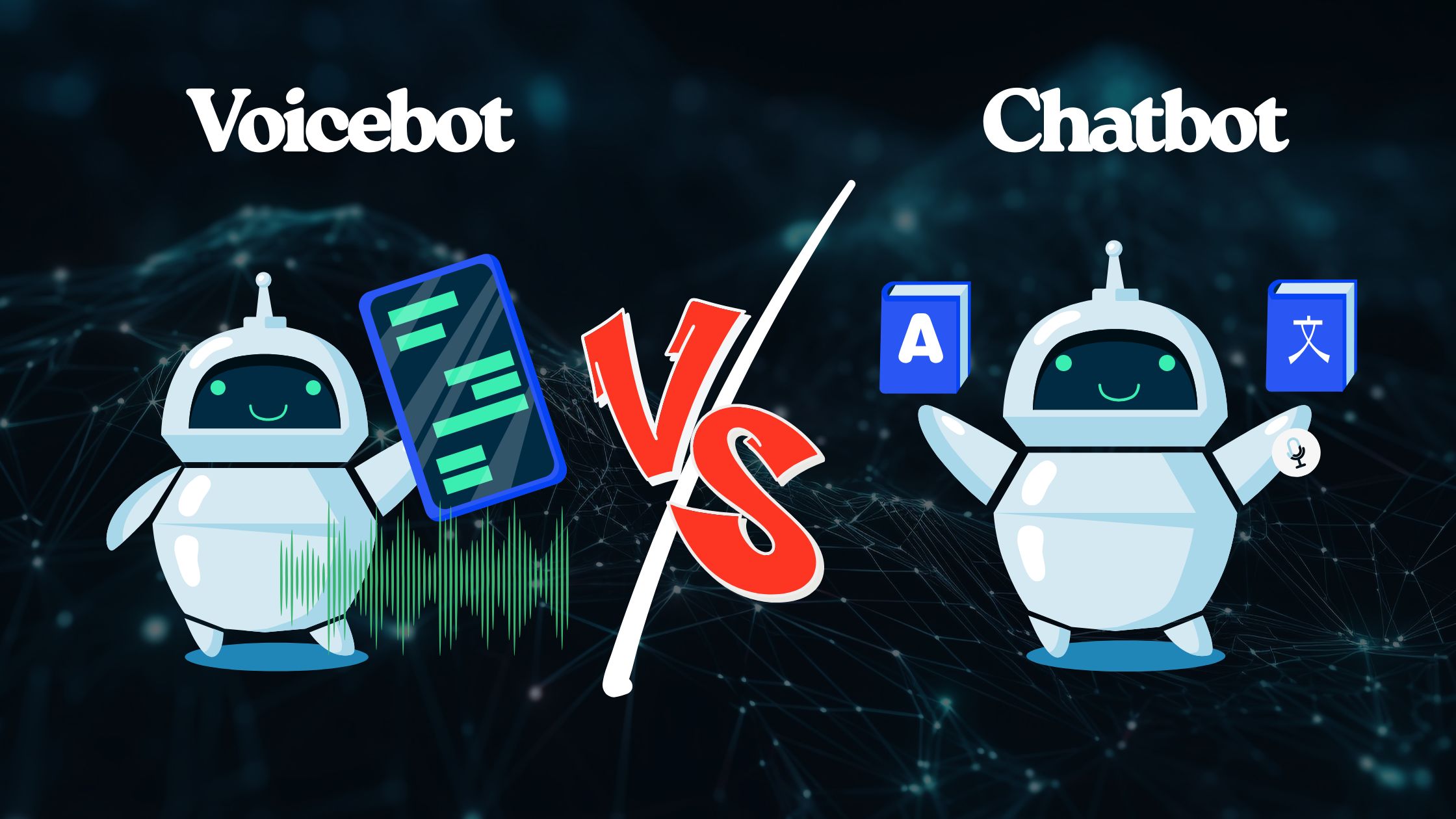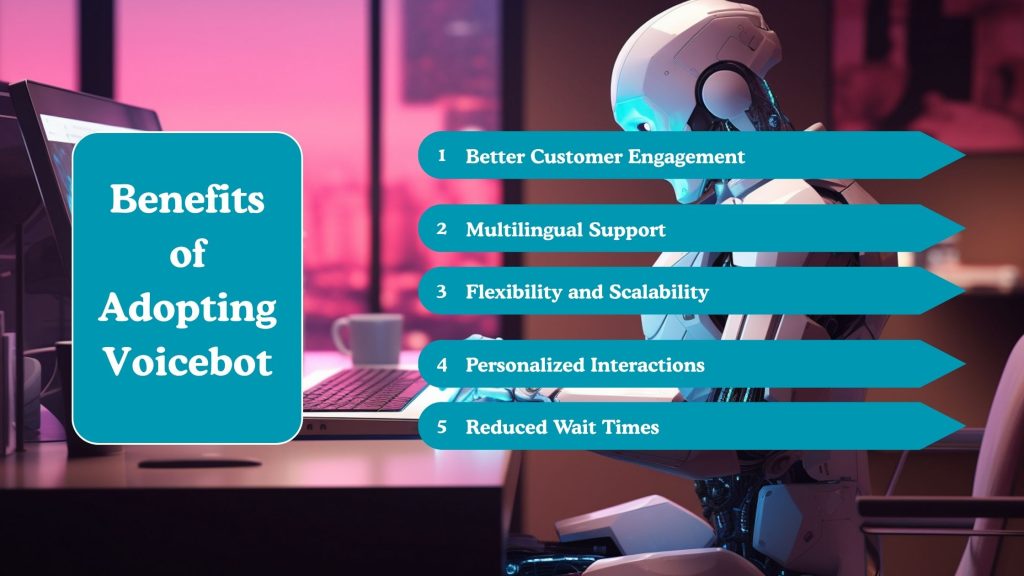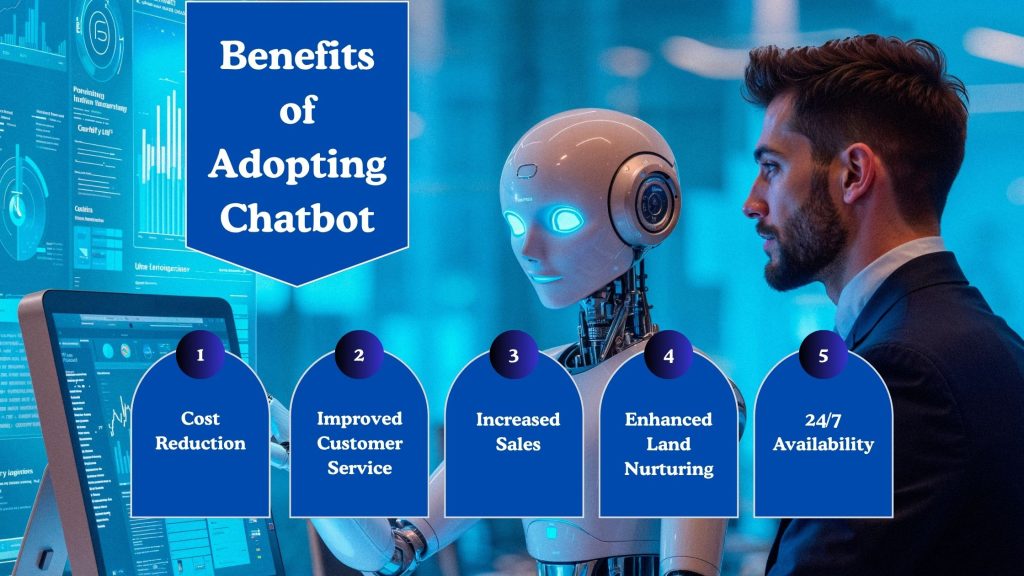
Voicebot vs Chatbot: Which Conversational AI Is Right for You?

Blog Summary:
In this blog, we explore the key differences between voicebots and chatbots, examining how each works, their unique benefits, and where they shine best. You’ll learn about real-world examples, technical implementations, and how these tools impact customer experience. Whether you’re planning to integrate voicebot software or a text-based chatbot, this guide will help you decide which fits your business goals better.
Conversational interfaces are transforming how businesses interact with customers, and two of the most prominent technologies leading this shift are voicebot vs chatbots. These tools automate interactions and offer faster, more accessible support, but they function in different ways and serve different user needs.
As companies scale, choosing the right communication tool becomes essential. Some prioritize speed and convenience through voice interactions, while others benefit more from structured, text-based automation. Understanding the distinction between a voicebot and a chatbot helps determine which solution aligns best with your goals and customer expectations.
With the rise of voicebot software and chatbot platforms, the decision isn’t just about tech—it’s about enhancing engagement, cutting costs, and delivering better customer service.
A Quick Intro on Voicebot
A voicebot is a type of conversational AI system that interacts with users through spoken language, unlike chatbots that rely on text input. Voicebots process and respond to voice commands in real time. They are designed to understand natural language, convert speech to text (STT), analyze the intent, and deliver a spoken response through text-to-speech (TTS) technology.
These systems are commonly used in customer support, virtual assistants, smart devices, and call centers. Voicebots can handle a wide range of tasks such as answering queries, booking appointments, or guiding users through a process, all without requiring a human agent. The ability to interact hands-free makes them especially valuable in scenarios where typing isn’t feasible or convenient.
With advancements in voicebot conversational AI, these tools are becoming increasingly accurate, responsive, and personalized, paving the way for more seamless and human-like interactions across industries.
How Does a Voicebot Work?
A voicebot works by converting spoken words into text using speech recognition. It then processes this text through natural language understanding to figure out what the user wants. Based on the intent, it selects a suitable response and converts it back into speech using text-to-speech technology. This allows for real-time, hands-free communication. Modern voicebot software also learns from user interactions to improve accuracy and personalization over time.
5 Benefits of Adopting Voicebot

Implementing a voicebot can offer several practical advantages for businesses seeking to streamline communication and enhance the customer experience. Below are five key benefits:
Better Customer Engagement
Voicebots provide a more natural and intuitive way to communicate, enabling users to speak instead of typing. This can increase engagement, especially for users who prefer quick, hands-free interactions, such as while driving or multitasking.
Multilingual Support
Advanced voicebot software supports multiple languages, helping businesses cater to diverse customer bases. This feature is particularly useful for global brands looking to offer localized experiences without hiring separate language agents.
Flexibility and Scalability
Voicebots are easily scalable to handle thousands of conversations simultaneously without compromising performance. As your business grows, a voicebot can scale to meet increasing interaction volumes without incurring additional operational costs.
Personalized Interactions
Modern voicebot conversational AI solutions can remember past interactions and customer preferences, enabling personalized conversations. This makes users feel more understood and valued, improving brand loyalty.
Reduced Wait Times
By instantly responding to queries and guiding users through processes, voicebots eliminate the need to wait for a human agent. This not only saves users time but also reduces the burden on support teams.
Popular Examples of Voice Bots
Voicebots have become an integral part of our daily lives, thanks to the increasing use of smart devices and virtual assistants. Below are two of the most widely recognized voicebot software solutions:
Alexa
Developed by Amazon, Alexa is one of the most popular voicebots in the world. It powers Echo devices and enables users to play music, control smart home gadgets, set reminders, shop online, and get real-time information—all through voice commands.
Its ability to understand and respond in natural language makes it a leading example of voicebot conversational AI.
Google Assistant
Integrated into Android smartphones and Google Home devices, Google Assistant enables users to interact with their devices using voice commands. From checking the weather and managing daily tasks to navigating directions or sending messages, it handles a wide range of voice-driven tasks. Its deep integration with Google services also makes it highly efficient and context-aware.
Looking to Automate Customer Conversations?
While voicebots are evolving fast, intelligent chatbots remain the go-to solution for businesses aiming to streamline support and boost engagement.
A Quick Intro on Chatbot
A chatbot is a software application designed to simulate human-like conversations through text. Unlike voicebots that rely on spoken input, chatbots interact with users via messaging interfaces on websites, apps, or social media platforms. They can handle customer queries, assist with transactions, and even guide users through processes—all through a simple chat window.
Chatbots operate based on predefined scripts, rule-based flows, or more advanced natural language processing to understand and respond to user input. Their primary goal is to automate conversations, minimize the need for human intervention, and provide instant support. Over time, with the advancement of AI, chatbots have become more contextual and intelligent, making them a staple in modern customer support systems.
How Does a Chatbot Work?
A chatbot works by receiving a user’s message, analyzing the text, and responding with a relevant reply. Basic chatbots operate on rule-based logic, using predefined scripts or decision trees to guide the conversation. For example, if a user types “What are your business hours?”, the chatbot matches this with a preset response.
More advanced NLP (natural language processing) chatbots are used to understand context, intent, and variations in human language. These AI-powered chatbots can learn from past interactions, making their replies more accurate and human-like over time.
Whether it’s a simple FAQ assistant or a complex virtual agent, the goal of a chatbot is to automate interactions, improve efficiency, and offer round-the-clock support across messaging platforms.
5 Benefits of Adopting a Chatbot

Chatbots have become a crucial part of digital communication strategies due to their efficiency, cost savings, and 24/7 availability. Here are five key benefits of adopting a chatbot:
Cost Reduction
By automating routine queries and processes, chatbots significantly cut down the need for large support teams. This helps businesses reduce overhead costs while maintaining consistent customer service.
Improved Customer Service
Chatbots offer instant responses to common questions, minimizing delays and enhancing user satisfaction. With predefined flows or intelligent AI, they ensure customers get accurate answers without waiting for a human agent.
Increased Sales
Many businesses use chatbots to guide users through the sales funnel, recommending products, answering purchase-related queries, and even helping complete transactions. This can lead to faster conversions and increased revenue.
Enhanced Lead Generation and Nurturing
A well-designed Lead Generation Chatbot can capture visitor information, qualify leads, and nurture them through personalized messages or follow-ups, making it a valuable tool for marketing and sales teams looking to improve conversion rates.
24/7 Availability
One of the biggest advantages of chatbots is their ability to operate 24/7. Regardless of time zones or business hours, they provide uninterrupted support to users across platforms.
For businesses seeking to enhance automation and efficiency, our chatbot development services can help you create custom solutions tailored to your specific goals.
Popular Examples of Chatbots
Chatbots are widely used across industries, with several well-known examples showcasing their versatility and capabilities. Here are two popular chatbot implementations:
Siri
While often recognized as a voice assistant, Apple’s Siri also functions as a chatbot when interacting through text. It can answer questions, send messages, perform tasks, and provide information using natural language processing. Siri combines both voice and text input, making it a hybrid conversational agent with chatbot functionality.
ChatGPT
Developed by OpenAI, ChatGPT is an advanced AI-powered chatbot known for its human-like conversations. It can perform a wide range of tasks, from answering questions and writing content to offering support and creative ideas. Many businesses are now integrating ChatGPT into customer service platforms to handle complex queries and improve response quality.
These examples demonstrate how chatbots can go beyond basic scripts to deliver intelligent, interactive experiences.
Key Differences Between Voicebot vs Chatbots
Voicebots and chatbots both aim to automate conversations, but they differ significantly in how they interact, their technical setup, and their role in the user experience. Here’s a detailed look at how they compare:
Interaction Medium
Voicebots use spoken language to communicate. They require a microphone to capture the user’s voice and speakers to deliver responses. This medium is ideal for hands-free environments—like while driving, cooking, or when screen access is limited. Voicebots create a more human-like conversational experience by responding in real time with natural voice modulation.
Chatbots, in contrast, function through text-based interactions. They appear on websites, apps, or messaging platforms like WhatsApp or Facebook Messenger. Users type questions or commands, and the chatbot replies in text format. This makes them a perfect fit for digital channels where typing and reading are preferred or more convenient.
Use Cases
Voicebots are commonly used in industries where fast, hands-free communication is needed. They’re ideal for call centers, customer support IVRs, smart home devices, healthcare appointment booking, and voice-enabled banking services. Their voice-driven nature makes them helpful for users who cannot or prefer not to type.
Chatbots are commonly used for customer support, e-commerce assistance, onboarding, and handling FAQs. They perform well on websites, in-app systems, and messaging platforms. Their ability to share images, links, or form fields makes them effective for more structured tasks, such as order tracking, form submissions, or lead collection.
User Engagement
Voicebots often create more natural engagement due to their conversational tone and vocal output. Since speaking is more intuitive than typing for many users, voicebots can more closely mimic real human interaction. This can enhance emotional connection and reduce user frustration during complex support scenarios.
Chatbots deliver structured, concise conversations. They are best for scenarios where users need precise answers quickly, such as checking account status or booking appointments. Although less emotionally engaging than voicebots, chatbots allow users to re-read information and engage at their own pace.
Personalization
Voicebots can deliver highly personalized interactions by recognizing speech patterns, adjusting tone, or even detecting mood based on voice inflections. With access to past conversation history and CRM data, voicebots can tailor responses based on user behavior, preferences, or location.
Chatbots also offer personalization through data tracking and integration with backend systems. They can greet users by name, suggest products based on browsing history, and tailor conversation flows to previous actions. While their personalization is effective, it’s limited to text-based customization.
Technology and Implementation
Voicebots require advanced technology such as Automatic Speech Recognition (ASR), Natural Language Understanding (NLU), and Text-to-Speech (TTS). This makes their development more complex and resource-intensive. They must be trained to handle various accents, background noise, and spoken language nuances.
Chatbots can be simpler to implement, especially if they follow rule-based flows. AI-powered chatbots still use NLU, but without the need for speech components. This makes deployment faster and more affordable for businesses just starting with conversational automation.
Customer Experience
Voicebots provide a more natural and seamless user experience by allowing real-time verbal interaction. They’re especially useful for customers who prefer speaking over typing, or for those with accessibility needs. This approach can lead to greater satisfaction and reduced friction in support processes.
Chatbots excel in clarity and convenience. Since users can take their time to type and read responses, the interaction feels more controlled. Chatbots are also less prone to environmental interference (like noise), which can affect voicebot performance. They’re great for quick queries or tasks requiring visual elements.
Complexity
Voicebots are inherently more complex due to the voice technology stack they require. Training them to understand varied speech, handling interruptions, and generating natural-sounding replies adds to development time and cost. They also require more rigorous testing in real-world scenarios.
Chatbots, on the other hand, are easier to maintain and scale. Even AI-based chatbots can be developed using pre-built platforms and updated without requiring significant technical effort. They offer a quicker ROI for businesses with limited tech resources or smaller budgets.
Platform Integration
Voicebots are integrated into platforms like call center software, smart devices (e.g., Alexa, Google Home), or mobile apps with voice interface support. These require API integrations, audio processing pipelines, and often a custom UI or IVR setup, depending on the use case.
Chatbots are more flexible when it comes to integration. They can be added to websites using a simple script or connected to platforms like Slack, Microsoft Teams, and WhatsApp via APIs. Their integration process is typically smoother and more standardized across industries.
Looking for a Smarter, Faster Support Solution?
Chatbots are text-based, easy to integrate, and handle multiple queries at once—making them the ideal choice for digital-first businesses.
Voicebot vs Chatbot: Which Is Best for Your Business?
Choosing between a voicebot and a chatbot depends entirely on your business needs, user preferences, and the platforms where your audience engages most.
If your customers often reach out via phone, or if your services involve hands-free situations—such as in logistics, healthcare, or smart device control—then a voicebot may be the better choice. It offers real-time, conversational interaction that feels more human and is ideal for multitasking environments. Voicebots are also excellent for accessibility, helping visually impaired users or those who prefer speaking over typing.
On the other hand, if your audience typically connects through websites, messaging platforms, or mobile apps, a chatbot is often a more suitable option. It allows for quick, guided responses, can display images or buttons, and supports asynchronous communication, where users can respond in their own time. Chatbots also tend to be more cost-effective and easier to maintain, especially for businesses looking for a quick setup with immediate results.
For most companies, especially those focused on digital platforms, chatbots alone often deliver optimal results. However, a hybrid approach may benefit businesses that have both web-based and voice-based customer touchpoints. The goal isn’t to choose one over the other, but to align the tool with your business strategy and how your customers prefer to engage.
Looking to build the right solution for your business? Explore our Custom Machine Learning Development Services to enhance your voicebot or chatbot with intelligent automation.
Find the Right AI Solution for Your Business with BigDataCentric
At BigDataCentric, we specialize in building powerful, customized chatbot solutions designed to automate workflows, enhance customer support, and drive real-time engagement. Our chatbot development tools & services are tailored to meet your business goals—whether it’s generating leads, offering instant customer assistance, or integrating intelligent automation into your digital ecosystem.
Our chatbots are built to deliver measurable value:
- 24/7 customer support with instant responses
- Multi-platform integration (website, WhatsApp, Facebook, and more)
- Smart lead qualification using conversational flows
- Personalized user experiences powered by machine learning
- Scalable automation that reduces operational costs
We also offer expert consulting for businesses exploring voicebot conversational AI. Still, our core strength lies in crafting high-performing chatbots that adapt to your users and grow with your business.
Still Confused Between Voicebot and Chatbot?
Chatbots are the smarter, proven choice for businesses ready to automate support, capture leads, and boost engagement—fast and effectively.
Summing up
Both voicebots and chatbots play a significant role in shaping the future of customer interaction. While voicebots offer a more human-like and hands-free experience, chatbots excel in accessibility, ease of integration, and cost efficiency. The best choice depends on your business model, audience behavior, and long-term goals.
For most digital-first businesses, chatbots provide the ideal starting point due to their flexibility, scalability, and ability to handle a wide range of customer interactions across platforms. As conversational AI continues to evolve, combining both tools may offer even greater value.
Ready to enhance your customer experience with a custom-built chatbot? Connect with BigDataCentric and let’s build a smarter communication strategy for your business.
FAQs
-
Can voicebots and chatbots work together?
Yes, voicebots and chatbots can work together in a unified system. Many platforms integrate both to offer users the flexibility to switch between voice and text depending on the device, environment, or preference.
-
What are the three types of chatbots?
The three main types are: 1. Rule-based chatbots (use predefined flows) 2. AI-powered chatbots (use NLP and ML to understand context) 3. Hybrid chatbots (combine rule-based logic with AI capabilities)
-
What are the limitations of voicebots vs chatbots?
Voicebots may struggle in noisy environments, require more processing power, and often lack support for visual content. Chatbots, on the other hand, can be slower in user interaction and may lack the hands-free convenience voicebots offer.
-
How secure are voicebots vs chatbots?
Both can be secure if implemented correctly, but voicebots carry added risks like voice spoofing and unintended background activation. Chatbots mainly face text-based vulnerabilities like data leakage or input manipulation.
-
Can voice bots work with wearable tech like chatbots?
Yes, voicebots can work with wearables such as smartwatches and AR glasses. They often enhance usability by enabling hands-free interaction, especially in mobile or on-the-go scenarios.

About Author
Jayanti Katariya is the CEO of BigDataCentric, a leading provider of AI, machine learning, data science, and business intelligence solutions. With 18+ years of industry experience, he has been at the forefront of helping businesses unlock growth through data-driven insights. Passionate about developing creative technology solutions from a young age, he pursued an engineering degree to further this interest. Under his leadership, BigDataCentric delivers tailored AI and analytics solutions to optimize business processes. His expertise drives innovation in data science, enabling organizations to make smarter, data-backed decisions.
Table of Contents
Toggle